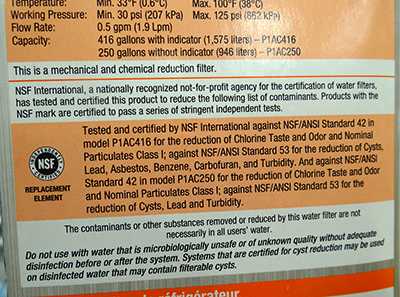Choosing Home Water Filters & Other Water Treatment Systems
Steps When Considering Water Filters
This information is designed as a guide for household water treatment, not a recommendation. Before installing a household water treatment system, contact your local health department’s environmental health group for consultation.
Not all filters are created equal
Different water filters have different functions. Some can make your water taste better, while others can filter out harmful chemicals or germs. No single filter can keep every type of contaminant out of your drinking water, and not everyone needs a water filter.
The water that comes to your tap actually contains small quantities of many other substances. Some of these are beneficial, such as the appropriate amount of a disinfectant, like chlorine, that helps keep your water safe from germs and fluoride, which helps prevent tooth decay. Other substances that might be in water can be harmful, such as lead and the germ Cryptosporidium. Filters can remove both good and bad substances from your water. Depending on your circumstances, filtering your water might not be a good idea.
There are many different types of filters available, and it can be confusing to decide whether you need one or which kind is best for you. In many areas of the world, the water is not safe to drink, so filtration is one option to protect your health. Here are some steps to consider when determining whether you want to use a water filter, and if so, what type and functions best fit your specific needs and preferences.
What are NSF ratings?
 NSF International is an independent organization that develops public health standards for products. One way to figure out what a water filter does is to look for an NSF certification on the label. You can look up specific products in the NSF database online to see what they are certified to protect against. Some of the NSF standards applicable to water treatments are standard 41 (taste and odor), 53 (cyst reduction), 58 (reverse osmosis), and 62 (distillation).
NSF International is an independent organization that develops public health standards for products. One way to figure out what a water filter does is to look for an NSF certification on the label. You can look up specific products in the NSF database online to see what they are certified to protect against. Some of the NSF standards applicable to water treatments are standard 41 (taste and odor), 53 (cyst reduction), 58 (reverse osmosis), and 62 (distillation).
What is the "pore size" of a filter?
The pore size is the size of the tiny holes in a filter that let water through. Think of a strainer or colander: The smaller the pores, the smaller the contaminants they keep out. If a filter has an "absolute" pore size of 1 micron, for example, each and every one of the filter's pores is 1 micron or smaller. This means that any contaminant larger than 1 micron, like Cryptosporidium, will be caught in the filter and will not go into the filtered water. Filters with a "nominal" or "mean" pore size of 1 micron have an average pore size of 1 micron which means that some pores are smaller and some pores are larger than 1 micron, so contaminants like Cryptosporidium can travel through the larger pores and into the water you filter.

- Page last reviewed: June 3, 2014
- Page last updated: June 3, 2014
- Content source:


 ShareCompartir
ShareCompartir